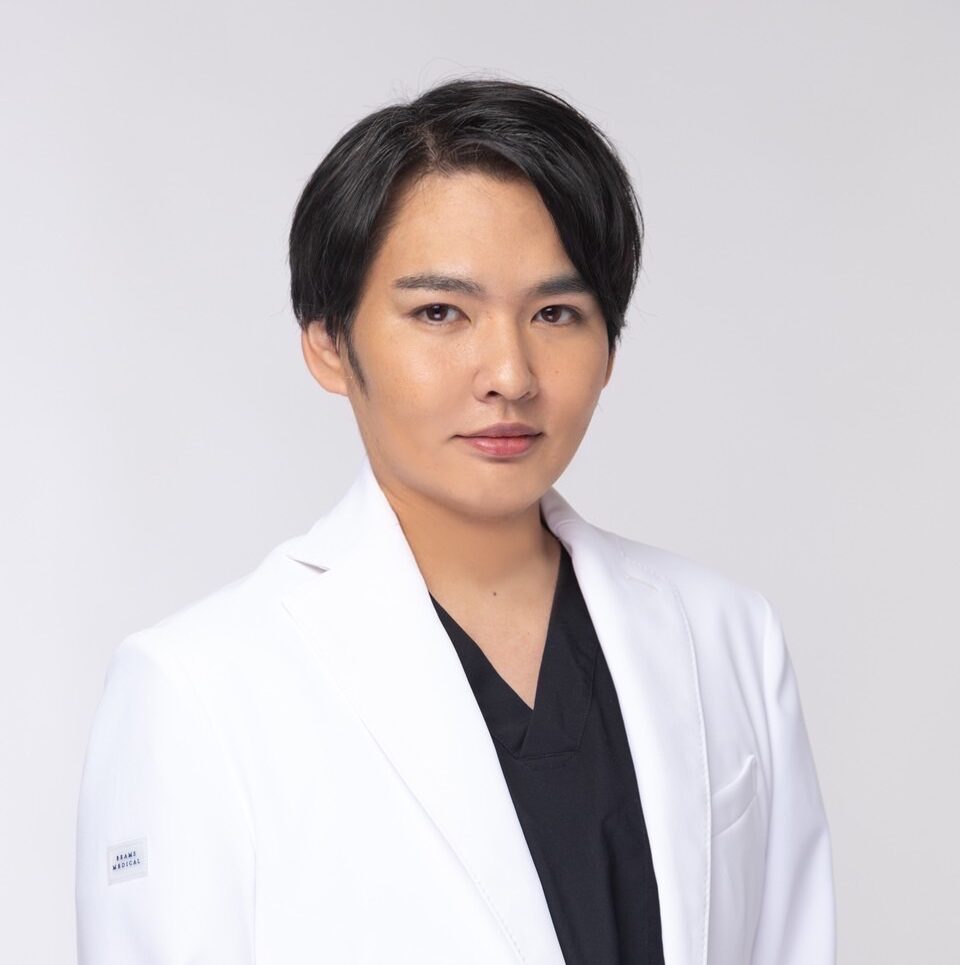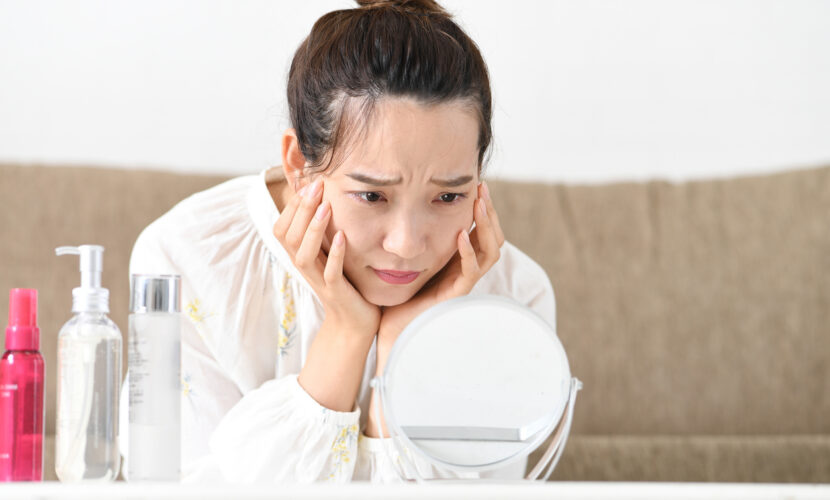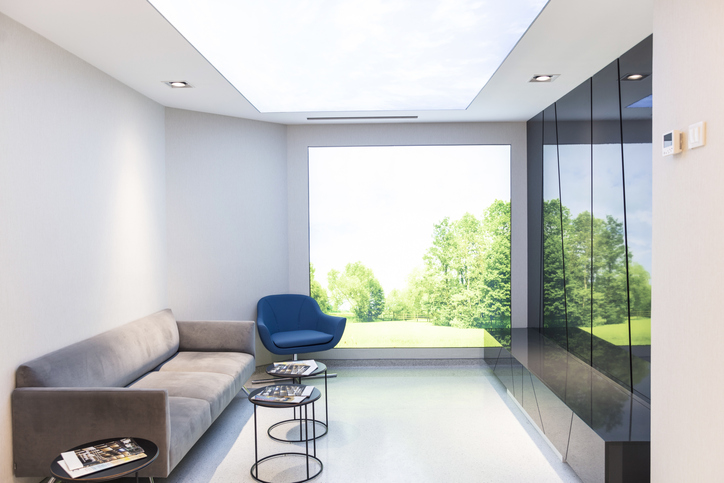Are you suffering from skin problems such as "I'm moisturizing my skin well, but somehow it won't go away," or "My T-zone is shiny, but my cheeks are dry..."? Do you have such contradictory skin problems? The cause of your skin problems may be the skincare you are continuing to use for the best of your intentions.
In fact, the more you moisturize, the better. In fact, "over-moisturizing" can adversely disrupt the skin's barrier function and cause new skin problems such as acne and enlarged pores.
Here, we provide a thorough explanation of the scientific mechanism of why "over-moisturizing" can be detrimental to your skin from a professional dermatological perspective. From a self-checklist to check whether your own care is "over-moisturizing," to the optimal skincare method for your skin type, to professional solutions when you feel the limitations of self-care, we will provide you with concrete knowledge to lead your skin to a healthy state with the "ability to moisturize itself.

Graduated from the Faculty of Medicine, National Kumamoto University. After serving as the director of major beauty clinics in Japan, etc., he opened Aladdin Aesthetic Clinic in 2023. He is a professional in aesthetic medicine with a doctorate in anti-aging research and many years of experience. With the motto of "Toward the realization of cosmetic medicine without lies," he aims to be the "Only One" together with his patients.
- Could it be me too? Self-check for "over-moisturizing" danger level
- A Doctor Explains 3 Scientific Mechanisms Why Moisturizing Too Much Can Have the Opposite Effect on Skin
- No more hesitation! Change your mindset from "giving" to "nurturing" skin care
- Doctors teach the best care not to over-moisturize, according to skin type and purpose.
- What If Self-Care Doesn't Improve? The option to turn to a specialist
- summary
Could it be me too? Self-check for "over-moisturizing" danger level
We take good care of our skin every day, but what if that careful moisturizing is unintentionally putting a strain on our skin, causing roughness and acne? However, if this careful moisturizing is unintentionally putting a burden on the skin and causing rough skin and acne.... If you do not believe in the skin's natural "ability to moisturize itself," you may be giving it too much, thereby preventing it from becoming self-sufficient.
Here we have prepared a 10-item self-checklist to help you objectively review the signs of "excessive moisture" emitted by your skin and the signs of "overdoing" in your skin care habits. Please check them honestly as if you were facing your own skin.
Diagnosis by Skin and Habits|Checklist of Your "Over-Moisturizing" Danger Level
Our skin is very honest. If we give it too much, it will give signs; if it is healthy, it will remain calm. In particular, if we continue to over-moisturize, it is not uncommon for the skin to feel hydrated on the surface, but internally it is beginning to lose its balance.
In many cases, skincare has become a kind of "talisman," and the psychology of "I'm worried if I don't do this" encourages excessive care.
The following list includes both signs of direct skin complaints and care that has unconsciously become habitual. One by one, reflect on your own situation and count the items that apply.
| No. | checklist |
|---|---|
| 1 | The skin is moisturized immediately after skincare, but during the day, the T-zone is shiny and the cheeks are dry. |
| 2 | Lotion and serum are less easily absorbed into the skin (feel like they stay on the skin) than before. |
| 3 | Unexplained white pimples and recurring pimples around the chin that are difficult to heal. |
| 4 | Skin may be slightly red or itchy after skin care. |
| 5 | I feel that my pores and blackheads are more noticeable than before. |
| 6 | I need at least four different skin care items, layered at all times, to feel comfortable. |
| 7 | It is customary to wear a sheet mask daily or for at least 15 minutes at a time. |
| 8 | If they feel even the slightest bit of dryness, they apply several layers of mist lotion or cream during the day. |
| 9 | She likes oil beauty and uses mainly oil-based products for both cleansing and skin care. |
| 10 | After nighttime skin care, the skin is so sticky that it sticks to the pillow and goes to bed. |
If you have 0-3, there may be little to worry about at this time. It is most likely that your current skin care regimen is appropriate for your skin, but skin conditions change on a daily basis. Keep listening to your skin and give it the care it needs, just as it needs it.
From 4 to 6 may be a preliminary sign. This may be a sign that your well-meaning care is beginning to take a toll on your skin. It is time to understand the mechanism of over-moisturizing, which will be explained in the next chapter, and consider subtracting from your skin care regimen.
If there are more than 7 items, the skin's ability to moisturize itself has decreased, and it is likely that the skin is in a vicious cycle of over-moisturizing. By adding more and more items, you may be inadvertently disrupting the skin's barrier function. Let's learn the root causes of why over-moisturizing is bad for the skin in the next chapter.
A Doctor Explains 3 Scientific Mechanisms Why Moisturizing Too Much Can Have the Opposite Effect on Skin
If you feel "Maybe I have it too..." during the self-check, don't worry. Once you know the cause of your skin problem, you will be able to find a solution. In fact, there is a scientific reason why a well-meaning moisturizer can have the opposite effect.
Why does giving too much cause skin problems? Here, we will explain the mechanism in detail from the perspective of dermatology, dividing it into three aspects. By the time you finish reading this, your thinking about skin care may change dramatically. Let's take the first step toward understanding the skin mechanism correctly and regaining healthy skin.
Reason 1|Overprotection of the skin! The function to moisturize itself is disrupted.
Our skin has a wonderful system called the "barrier function," which originally protects us from external stimuli and prevents internal moisture evaporation. This system is made up of three main components: (1) the sebum film, a natural cream made of sebum; (2) NMF (natural moisturizing factor), which holds in moisture; and (3) intercellular lipids (ceramides, etc.), which fill the spaces between horny cells like cement.
However, if we continue to apply excessive amounts of lotion and cream every day, the skin will decide that it does not need to work hard to produce its own moisture if it can receive sufficient moisture from the outside, and it will develop a "lazy habit," so to speak. This is the true meaning of "overprotecting" the skin. The balance of "homeostasis," in which the skin always tries to maintain a constant healthy state, is disrupted by excessive care.
As a result, sebum secretion and ceramide production capabilities are reduced, resulting in "skin that cannot stand on its own" that quickly becomes dry without skincare. This mechanism is largely responsible for the fact that the more you moisturize, the more you are stuck in a spiral of dryness.
Reason 2|Feeding acne! Excess oil is a breeding ground for acne bacteria
I moisturize my skin well, but for some reason I get acne all over again. This is one of the typical problems caused by over-moisturizing. The acne-causing bacteria, Acne bacillus, is actually a common bacterium that everyone has on their skin. Normally, it does not do anything wrong, but when it proliferates under certain conditions, it causes inflammation, which leads to acne. The conditions for proliferation are sebum (oil) and a low oxygen environment.
The oils contained in highly moisturizing creams and beauty oils are excellent "food" for acne bacteria. Excess oil on the surface of the skin due to over-moisturizing causes acne bacteria to grow vigorously. Furthermore, covering the skin with a greasy cream can block the pores and create an environment where oxygen cannot reach the skin.
This is the most comfortable home for acne bacteria. The Japanese Dermatological Association's "Guidelines for the Treatment of Acne Vulgaris" also recommends a less oily skin care regimen for acne-prone skin. Over-moisturizing is like providing food and a comfortable environment for acne bacteria.
Reason 3|Blistering of keratin! Excessive moisture causes the barrier to become brittle, "keratinous maceration".
We have all experienced the wrinkling and blistering of fingertips after a long bath. This phenomenon can actually occur on facial skin as well. This is a condition called "keratin soaking," in which the horny layer of skin literally becomes blistered due to excessive water content.
For example, the act of applying a sheet mask for longer than the prescribed time or repeatedly patting on lotion is the same as intentionally causing keratin maceration. At first glance, the skin seems to be filled with moisture and moist, but this is a very dangerous sign. The stratum corneum, bloated with moisture, has a brittle structure due to the loosening of cell-to-cell bonds.
Imagine a strong wall made of bricks (keratinocytes) and cement (intercellular lipids) that has become brittle due to water immersion. In this unprotected state, even the slightest irritation from external allergens, bacteria, or friction can easily penetrate inside, causing itching, redness, and further skin irritation.
No more hesitation! Change your mindset from "giving" to "nurturing" skin care
Over-moisturizing can interfere with the independence of the skin, and may even cause problems. We hope you now understand the scientific mechanism behind this. However, even if you know this in your head, you may still be at a loss as to what to do tomorrow. You may be at a loss.
From here, before we get into specific skincare methods, we will talk about the most important thing of all: changing your mindset. Let's let go of the conventional wisdom of skincare that we have believed in, and together let's prepare our hearts and minds to build a new relationship with our skin. The important thing is to move from "giving" to the skin to "nurturing" it. This shift in perspective is the key to fundamentally changing your skin.
What is the deeper psychology behind trying too hard to take care of your skin?
In this age of overflowing information on skin care, we tend to believe that "adding something extra" is the shortcut to beautiful skin. We try everything we hear that is good for our skin, and we spend a lot of time caring for our skin, piling up a number of items. This earnestness and quest for beautiful skin was not a mistake. In fact, it is a proof of the wonderful efforts you have made to seriously confront your own skin.
However, behind this behavior, there is a psychological need to feel reassured that "I am doing all this so I will be fine," or that careful skincare itself has become a kind of "ritual," and that by performing it, one is trying to stabilize one's mind. It is not uncommon for a genuine desire to "clean up the skin" to be replaced by a feeling of "I feel anxious if I don't do something," which is akin to an obsession.
If you are in a vicious cycle of over-moisturizing, it is not that you were not trying hard enough, it is just that your efforts were slightly misdirected.
The goal is "independent skin" that moisturizes itself with minimal care.
Why don't you put all the passion and effort you have put into skincare into a new goal? The true skin beauty that we should aim for is not the "created moisture" that can only be maintained by applying a lot of expensive beauty products. It is "self-sufficient skin" that can maintain healthy moisture on its own, even with very simple care such as lotion and milky lotion.
In this concept, skin care is no longer the "main actor" of your skin. The main role is played by the "regenerative ability" and "barrier function" of your own skin. The role of skincare is to play a supporting role, helping the main players to perform at their best. Gently remove dirt, supply a minimum amount of moisture, and protect against UV rays. The new normal for skincare from now on is to create an environment in which the skin can concentrate on its true job.
This shift in mindset will free you from the pressures of skin care and give you the opportunity to regain time, financial freedom, and most importantly, trust in the skin itself.
Care Transition Period! Preparation period for the skin to become independent
Many people who set their hearts on the goal of "independent skin" and begin to simplify their skincare regimen encounter a temporary barrier. This is a temporary feeling of dryness and tightness caused by the loss of the excessive moisture that had been provided. It is a waste of time and money to return to the original care, saying, "I don't need more moisturizer after all.
This is a "rehabilitation period" for the skin. Skin that has become accustomed to an overprotective environment over the years needs a little time to remember how to generate moisture on its own again and to start working again. Considering the turnover cycle in which skin cells are reborn, we recommend that you consider 2 weeks to 1 month as a preparatory period for the skin to adapt to the new environment.
Dryness at this time of year is evidence that the skin is working very hard right now to regain its natural strength. We should not rush or panic, but believe in our own skin and watch over it carefully, saying, "Don't worry, your strength is not like that. This gentle gaze will be the best support for your skin to become self-reliant.
Doctors teach the best care not to over-moisturize, according to skin type and purpose.
From "giving" care to "nurturing" care. Now that you have this new perspective, the next step is to confront your own skin. What do I really need and what do I not need? In order to clearly answer such questions, let's first learn the basics of moisturizers.
We will then provide you with a specific care plan that is best suited for your skin type. After reading this chapter, you will no longer be confused with a lot of skincare information. Find your own "axis of beautiful skin" and start a smart skincare regimen that is free from over-moisturizing.
Know the "three roles" of moisturizers
Did you know that moisturizers are actually classified into three main types according to their functions? Understanding the difference between these roles will help you avoid over-moisturizing your skin and choose the right item for your current needs. Get a professional perspective that will also help you when looking at the ingredient labels of cosmetics products.
| Type of Role | Main Function | Typical Ingredients | Main items included |
|---|---|---|---|
| humectant (moisture-binding humectant) |
It "catches and holds" moisture like a magnet. Moisturizes the skin. | Glycerin, hyaluronic acid, collagen, amino acids, PCA-Na | Lotion, serum |
| emollient (Softening and moisturizing agent) |
Fills gaps in the stratum corneum to "soften" the skin. Prevents moisture evaporation. | Ceramide, sphingolipids, squalane, natural vegetable oils | Emulsion, cream, serum |
| inclusive (occlusive humectant) |
It applies an oily film to the skin's surface and "strongly covers" it. Thoroughly prevents moisture evaporation. | Vaseline, mineral oil, lanolin, silicone oil | Creams, ointments, balms |
Knowing these roles, you should be able to logically understand the reason for the basic steps: lotion provides moisture (humectant), and milky lotion and cream bind and cover the moisture (emollient and occlusive).
Practice 1|Fill dry and inner dry skin from the inside out with ceramide.
There are two types of skin: those with "dry skin," which always feels dry, and those with "inner dry skin," which is sticky with sebum on the surface of the skin but dry inside. Both types of skin tend to lack intercellular lipids, the key component of the skin barrier function. Therefore, simply providing moisture and oil from the outside is not enough to keep the skin moist.
The key ingredient we recommend is ceramide, the main component of intercellular lipids. Ceramide has the important function of sandwiching moisture in the stratum corneum and preventing it from evaporating. Rather than using expensive creams to cover the skin with a strong lid, we should think of ceramide as rebuilding the skin's natural moisture retention structure.
After replenishing moisture adequately with lotion, choose a serum containing "human-type ceramide" or a milky lotion that is less sticky to hold moisture in place.
Practice 2|[Oily skin, acne-prone skin] balance oil and water with "vitamin C derivative".
Those with "oily/acne-prone skin," which is prone to active sebum secretion and suffers from acne and clogged pores, are the type most likely to suffer from the adverse effects of excessive moisturizing. The goal is not to deprive the skin of oil in the dark, but to maintain a balance between moisture and oil and control excessive sebum.
Vitamin C derivative is a reassuring ally for this type of skin. Vitamin C derivatives can be expected to inhibit excessive sebum secretion, and their antioxidant effect prevents the oxidation of sebum, helping to prevent blackheads in pores and the aggravation of acne.
Replenish moisture with a lotion with a refreshing feel, and make a serum containing a vitamin C derivative the center of care. For moisturizing items, it is recommended to choose a gel type with low oil content or to use only a thin layer of milky lotion to blend in. Also, when choosing products, make it a habit to check if they are labeled "non-comedogenic tested," which means that they have been tested to be less likely to cause acne.
Practice 3|The key to "mixed skin" is to use different products for different areas of the skin.
Mixed skin, in which the T-zone is sticky while the U-zone is dry, is a very common skin type among Japanese people. The most common mistake that people with this type make is to apply the same skin care to the entire face. This leaves the T-zone prone to acne and does not improve the dryness of the U-zone.
The biggest key to attacking combination skin is to use different items for different parts of the body. Let go of the belief that "the same item must be applied to the entire face.
First, apply a refreshing toner to the entire face. Then, apply a ceramide-containing serum or milky lotion over the U-zone (cheeks and mouth area), which is prone to dryness. On the T-zone (forehead and nose), which tends to be sticky, it is sufficient not to apply anything or to lightly press the remaining milky lotion on your hands. Observe your skin carefully and give only what is needed, where it is needed, and only as much as needed. This careful personalized care is the shortest route to stabilizing combination skin.
| skin texture | key component | Key Points of Care | Example of recommended steps |
|---|---|---|---|
| dry skin inner dry skin |
ceramide | It rebuilds the foundation of the barrier function and supports the ability to retain moisture from within. | Lotion + ceramide serum or emulsion |
| oily skin acne-prone skin |
vitamin C derivative | Controls excessive sebum and balances oil and moisture. | Lotion + Vitamin C derivative serum + (if necessary) oil-free gel |
| combination skin | Ceramide & Vitamin C derivative, etc. |
Determine the condition of the area and flexibly "use" different items and quantities. | (Whole face) Toner → (U-zone) Ceramide serum → (T-zone) No serum or a very small amount |
What If Self-Care Doesn't Improve? The option to turn to a specialist
Review your skin care philosophy and practice the best care for your skin type. This is undoubtedly the royal road to achieving independent and healthy skin. However, it is also true that there are deep-seated skin problems that you have been suffering from for years and areas that are inevitably difficult to approach with self-care alone.
If, despite your best efforts, you see no signs of improvement, it is by no means your fault. This is when you should remember the option of relying on a "skin specialist" instead of going it alone. A cosmetic dermatologist is like a reliable partner who can help you maximize the potential of your skin.
Start with an "accurate skin diagnosis"! Your assumptions may be overturned!
After many years of believing that they have oily skin and thoroughly avoiding oil, the results of a diagnosis using specialized equipment revealed that they actually have "inner dry skin" with a significant lack of moisture inside the skin.... This is not an uncommon case in the clinic. We tend to make "assumptions" about our own skin quality based on how our skin feels and looks on a daily basis. However, this self-judgment is often the cause of prolonged skin problems.
Cosmetic dermatology uses specialized skin diagnostic equipment such as VISIA to analyze in detail the deeper layers of the skin, which cannot be seen with the naked eye. The current "amount of moisture" and "amount of oil" as well as "number and depth of pores," "distribution of spots and freckles," "amount of acne bacteria," etc. are visualized as objective data.
Only based on the results of this accurate diagnosis will you be able to determine what care is truly necessary for you. Regardless of whether you decide to proceed with treatment or not, the first step is to correctly know where your skin is now. This may seem like a roundabout way, but it is the surest step toward beautiful skin.
Specialized Treatment 1|"Chemical peeling" to reset clogged pores and sebum
Blackheads and stubborn plugs in pores that are difficult to remove by self-care. Or, you may be concerned about recurring pimples and the dullness of their scars.... Chemical peeling" is one of the treatments suitable for those who have such problems.
In this treatment, carefully selected fruit acids (AHA) and salicylic acids (BHA) are applied to the skin to gently dissolve and remove dead skin cells and clogged pores that have accumulated on the skin surface. This action is expected to bring the skin's turnover (rebirth) cycle, which tends to be disrupted, back to a normal state.
Unclogging pores not only creates a skin environment that is less prone to acne, but also improves the overall transparency of the skin by clearing away dead skin cells and enhancing the penetration of daily skin care cosmetics. By incorporating this treatment as part of regular maintenance, it helps reset skin problems and build a foundation for maintaining healthy skin.
Specialized Treatment 2|"Dermapen 4" to draw out the skin's regenerative power
Dermapen 4 is often chosen by people who want to improve their skin quality more fundamentally, such as for cratering skin left by acne scars, sagging pores that become more noticeable with age, and overall lack of skin elasticity.
This treatment uses an ultrafine needle, thinner than a hair, to temporarily form microscopic holes on the surface of the skin that are invisible to the naked eye. This process strongly promotes the production of collagen and elastin, which control the elasticity of the skin.
This brings out the skin's ability to renew itself from the inside out, and is expected to improve the skin by smoothing out uneven acne scars, tightening pores, and bringing firmness and elasticity to the overall skin. Although there may be some downtime after the treatment, such as temporary redness, this treatment uses the skin's natural regenerative abilities to lead to a smoother, less rough skin texture.
summary
Here we have explained in detail the causes of skin problems caused by over-moisturizing and the scientific mechanisms involved. Not trusting the skin's natural ability to moisturize and overprotecting the skin can instead lead to a disruption of the barrier function, acne, and fragile keratinization.
The key is to shift your mindset from skincare as an act of "giving" to skincare as an act of supporting the skin to "grow" on its own. Let's start by reviewing our own skincare habits and correctly selecting key ingredients (ceramide, vitamin C derivatives, etc.) that suit our skin type.
If you do not see any improvement with self-care, or if you want to know exactly what your skin condition is, you should never suffer alone; relying on a specialist is an effective option. Please consider specialized treatments such as chemical peels and aim for "self-reliant skin" that maximizes the effects of your skin with minimal care. We hope this article will help you to free yourself from your long-standing skin problems.
At Aladdin Aesthetic Clinic, based on our many years of experience in cosmetic medicine and cosmetic dermatology and the knowledge of our doctoral degree, we provide counseling that aims to be "only one", offering the best treatment for each person we meet. We offer only the necessary treatments without any unnecessary information or suggestions.
Feel free to use our official LINE account for 24-hour counseling and reservations. Please feel free to contact us for free counseling for the first time or if you have any concerns.






